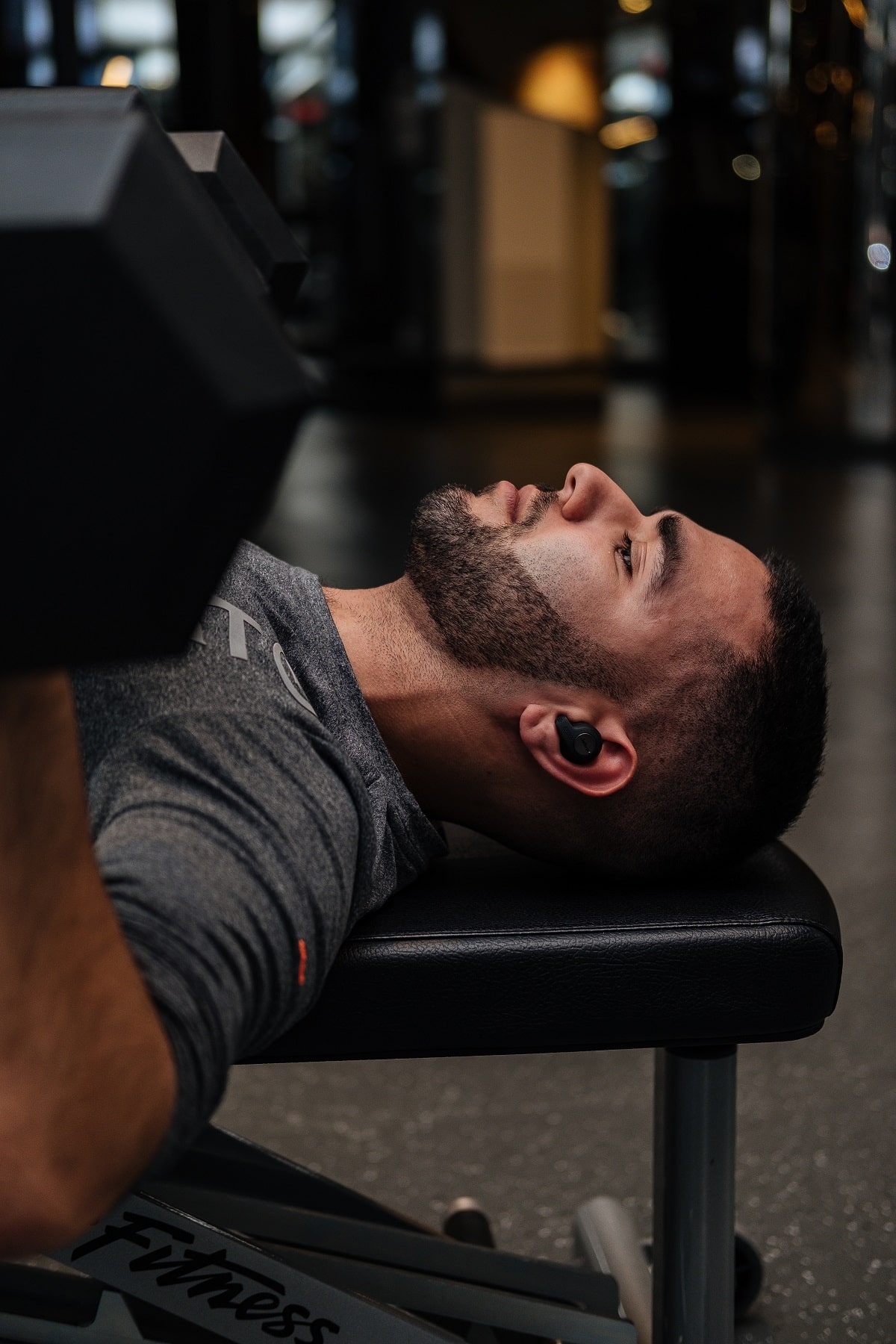1
HOME > Health & Fitness >
8 PROVEN TECHNIQUES FOR GAINING MASS
Written by Menswear Style in Health & Fitness on the 31st March 2023

Muscle building takes time and effort. Many people turn to fitness tips to speed up the process to gain more visible results faster. While using these tactics, it's important to maintain realistic expectations and really understand which ones will work for you and your goals. We have put together this list of techniques to help you build muscle mass at an accelerated pace. Each tactic offers tangible and efficient benefits for anyone looking for a way to see quicker results in their workouts. We’re going to look at:
- Incorporating compound exercises into your fitness routine
- Maintaining proper nutrition while getting enough rest
- Understanding how the best supplements for muscle growth can help improve your overall performance
Using this knowledge and experience, you can craft an individualised plan that works for you.
1. Up your training volume
Increasing your training volume can be an effective way to increase muscle growth. Volume is the total load placed on a given muscle or group of muscles, usually calculated by multiplying sets, reps, and weights. For example, if you flat barbell bench three sets of 10 reps at 100 pounds each time, your total volume for that session would be 3000 pounds. Additionally, there’s a specific rep range known to trigger hypertrophy or muscular gains, 8-15 reps per set, so it’s worth trying out increased rep ranges to get more out of your workout sessions. Remember, though, that if you choose a higher rep range, you may need to decrease your weights correspondingly. With all these considerations in mind, properly increasing your training volume should translate into more effective workouts and hypertrophy gains over time!

2. Train more often
Frequency is an important factor when it comes to developing muscle mass. With more frequent training, muscles have increased access to a stimulus for growth. When a muscle group is trained more often, there are greater chances for recovery and adaptation due to the continuous exposure of the muscle to a certain technique and type of workout. High frequency also allows for greater levels of protein synthesis, which is the key to building new muscle. Increasing frequency alone isn't enough to gain the most from exercising; it should be combined with varying techniques like super-setting, drop sets, rest-pause methods, and careful nutrition and rest. Proper recovery periods must be followed between workouts, as overtraining can prevent progress and lead to other health issues, such as fatigue or injury. Other than that, high-frequency training can improve strength and size effectively since it keeps your muscles constantly stimulated at regular intervals, making them stronger in a shorter period.
3. Increase your weightlifting
Consider lifting heavier weights if you want to build muscle mass and strength. By lifting heavy weights, you tear more muscle fibres, which triggers more muscle protein synthesis, making you bigger and stronger. Of course, “heavy” is relative, so you should choose challenging but not maximal weights to complete 8 to 15 reps before reaching fatigue. You can also focus on building strength using lower rep ranges of 4-6 reps, as long as sufficient load brings the muscles to failure. In either case, it takes dedication to reach your fitness goals. Proper technique is imperative when lifting heavy weights — choosing a weight that is too heavy could lead to serious injury — and nutrition is key for generating the necessary energy for successful workouts. Proper warm-ups and cool-downs also reduce the risk of muscular injuries and allow your body time to rebuild between sessions. Ultimately, lifting heavier weights slowly will help increase your overall strength and physical appearance.

4. Make compound lifts your thing
Compound lifts are essential to any fitness routine and can be used to build muscle mass, strength, and power. Compound exercises involve multiple joint movements and engage more than one muscle group in completing the exercise. This means your entire body is involved when doing a compound lift rather than focusing on just one isolated muscle group. Squats, for example, work many muscles, including your quads, hamstrings, glutes, core and even calves depending on how it’s done. In contrast, single-joint movements such as seated leg extensions target only a single muscle group while requiring little effort from your whole body, making them less effective than compound exercises. That said, single-joint exercises still have their place in an effective fitness program to isolate specific muscles or range of motion-related goals. But if you’re looking to build strength, power and muscle quickly - ditch the leg extensions and stick with multi-joint compound lifts like squats, deadlifts and press variations.
5. Add protein to your diet
Eating enough protein is critical for helping your body develop lean muscle mass and allowing it to heal from any muscle damage after workouts. It helps rebuild and fuel cells with energy, improving strength and endurance. You should aim for anywhere between 2–3g of protein per kg of body weight a day to get the proper balance of nutrients needed for optimal muscle growth and maintenance. For example, a person weighing 90kg should aim to consume 180-270g of protein daily to build or maintain their muscles actively. A more conservative estimate might be 0.8 g of protein per kilogram of body weight – so 72g per day – which is still enough protein in the diet to support active muscles and promote healing when necessary.

6. Use muscle building supplements
The right bodybuilding supplements are essential for maximum gains from your workouts and diet. Supplementing with creatine gummies can be an effective way to promote muscle growth. Studies suggest that some users can lift 14% more reps than those who opt out of supplements altogether. Creatine is often seen as one of the safest and most efficient supplement options for athletes seeking to increase their resistance training exercise performance. With a steady intake of proper doses, it has been reported that athletes have seen sustainable increases in reps during lifts and overall performance. Bodybuilders and anyone looking to optimise their results are increasingly using supplement stacks. Your physique can be sharpened, your training intensity can be increased, and your performance can be improved. Stacking creatine with supplements like SARMs, one of the best supplements for muscle growth, makes the process faster. Buy the purest SARMs UK or worldwide; if they're pure, they'll show you a purity certificate. Knowing exactly what to take, how much, and when is critical to developing an effective regimen tailored to your needs. You can reap maximum benefits from your hard work and dedication with the right combination of supplements.
7. Get your eight hours sleep
Sleep has long been essential for overall health, but it can also be a major factor in optimal muscle-building results. When you’re chronically sleep deprived, your workout efforts become exponentially harder, and you can lose your motivation to lift weights. Even one night of no sleep can decrease muscle-building opportunities, as protein breakdown increases with lack of rest. Providing your body (and muscles) with enough rest is key for successful muscle development and growth. Sleep facilitates muscle recovery by influencing hormones like cortisol, human growth hormone and insulin growth factor–all necessary for building muscle and maintaining your physique. The process of repairing muscles broken down while working out occurs mostly while we sleep, making proper shut-eye an important part of any fitness regimen. Get those seven, preferably eight, hours of good quality sleep if you want to build bigger muscles faster.

8. Make recovery a priority
Workout recovery is a key element of any successful fitness program. Ensuring the body has enough time to rest, rebuild and prepare for the next workout session is critical. Without this, the muscles will become stressed and fatigued over time which can lead to a decrease in performance and, eventually, overtraining syndrome. This can be avoided using workout ‘splits’, which target different body parts simultaneously throughout the week. A popular example is push-pull-legs split, which allows muscle groups to recover adequately between sessions. This allows for optimal growth and development of muscles while avoiding serious issues such as burnout and injury from overtraining.
Gaining Muscle Mass: The Bottom Line
It takes resistance training, a good diet, and the right supplementation to gain muscle. To build muscle, your workout program should primarily involve compound and isolation exercises with weights, but you should adjust the sets, repetitions, and exercises to ensure consistent, long-term gains. You need enough protein, fat, and calories to build muscle to exceed your daily energy expenditure. Using these techniques, almost everybody can build muscle mass with consistent training over months and years. The key to how to gain muscle? Lift hard, eat right, and supplement well to nail your goals.
Trending
2
3
4
5
6
7
8
9
10








